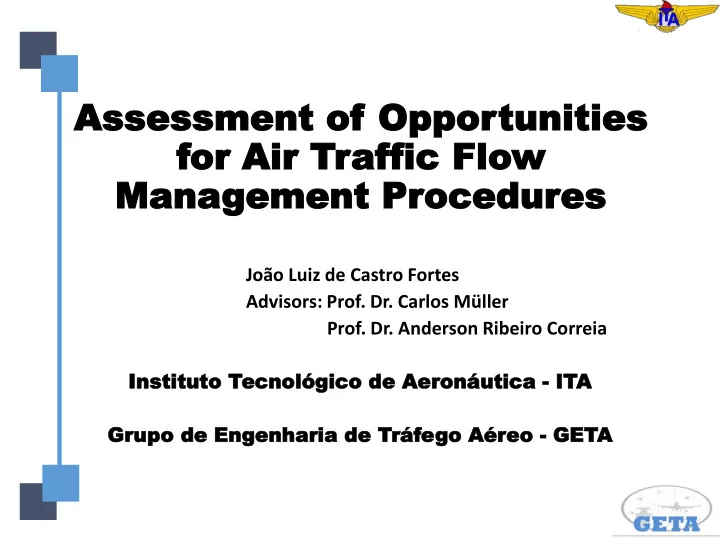

Assessm Assessment ent of of Oppor Opportunities tunities for Air or Air Traf affic fic Flo low Management Pr Mana gement Procedur ocedures es João Luiz de Castro Fortes Advisors: Prof. Dr. Carlos Müller Prof. Dr. Anderson Ribeiro Correia In Insti stituto tuto Tec ecno nológic lógico de de Ae Aeron onáu áutica ica - IT ITA Grup Gr upo de de En Engenhari ria de de Tráf áfego go Aér éreo eo - GE GETA
Agenda • Problem Contextualization • Preliminary Studies • Objectives • Data Gathering • Preliminary Results • Final Comments
Problem Contextualization • Air transportation in Brazil has grown significantly in last years • More use of the available infrastructure • Concern about delays and cancellations • Better use of airspace (optimization!)
Source: ANAC, 2013 2009 – 2010: 16% increase
Preliminary studies • Some results for traffic from São Paulo (SBSP) – Rio de Janeiro (SBSD) traffic • Use of radar database for flight trajectories study • Use of RAMS Plus for data analysis • Connect two main cities • One of the busiest routes in Brazil
Objectives • This research will develop a model, using Mixed Integer Programming, which optimizes the application of ATFM procedures during different flight phases • The model embodies ATFM procedures during departure sequencing, en-route and arrival sequencing • The research applies the model to flights operating over Southeast and Midwest Brazilian regions, as a case study • These regions concentrate the most congested Airports, Terminal Areas and En-Route Sectors in Brazil
En-route Re-routing Speed Control Arrival/Departure Departure/Arrival Sequencing Sequencing Holding Procedure Time + Ground Holding Alternatives STAR Departure Airport Arrival Airport
Average Time = ∆T Std Deviation = σ TMA-01 FIR’s Sectors DepA1 SID A1 ∆T, σ WYP01 ∆T, σ TMA-02 WYP02 WYP03 WYP04 STAR ∆T, σ ArrA2 ∆T, σ A2 ∆T, σ FIR’s Sectors
Average Time = ∆T • Alternative STAR’s Std Deviation = σ • Rerouting • Speed Control (Time) TMA-01 FIR’s Sectors DepA1 SID A1 ∆T, σ WYP02_Alt ∆T, σ WYP01 ∆T, σ TMA-02 WYP03_Alt ∆T, σ WYP04 ∆T, σ STAR ArrA2 A2 STAR- A FIR’s Sectors STAR- B
SBGR- SBBR S03 S05 S07 Resultados
• Modelling Costs for: • cancellations • Use of alternative routes • Arrival at a node out of schedule • O.F.: Min time • Variation of time through an arc • Air and ground delays • S.T. • Sequencing restrictions • Flight Restrictions • Delays restrictions
Preliminary results
Preliminary results
Preliminary results
Final Comments • Use of the optimization tool to aid decision making in ATFM • Identify how delays are distributed through airports and sectors
Thank hank you ou! João Luiz de Castr oão Luiz de Castro F o For ortes tes Gr Grupo upo de de E Enge ngenha nhari ria d a de T e Tráf ráfego go Aér Aéreo eo - GET GETA jlfor orte tes@gma gmail.co com
Recommend
More recommend